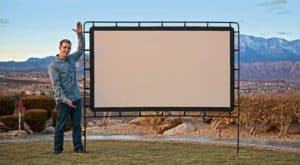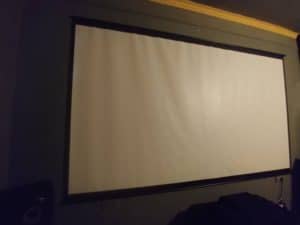
There are many options to choose from when looking for a new projector screen. You can build a projection screen relatively easily with some white fabric and black tape, but let’s be honest that is probably not what you thought of when you wanted a projector.
You may have questions about whether you should go with a tensioned vs non-tensioned projection screen and we are here to help you make an informed decision to help with your projector set up!
There are a few other types of projector screens out there, such as motorized, but these are the main contenders for most people getting not projectors and looking to perfect their movie rooms!
Benefits of a Tensioned Projection Screen
Tensioned projector screens are amazing for everyday use, they make sure your projection screen stays in place no matter what and isn’t constantly flying all over the place.
Tensioned screens have tabs all over the sides of the screen to stretch out the projector screen which creates tension making the screen rigid. You can find some more information on the topic from AVS, some people have expressed their advice on tab tensions.
This makes the screen the same each and every time you go to use it whereas with a non-rigid screen you can have a bit of variation especially if there is a lot of airflow in your projection room. Tensioned screens are mostly ideal for outside venues, as they won’t be affected by the wind which can be very annoying if you are watching outside.
Durability
Tab tensioned projection screens are made of vastly better quality materials and can last for years to come, unlike their non-tensioned projector screen counterparts. After researching the two options on the market now I found AVS which may help you get some real-world experiences from multiple people with the different types of screens.

Image quality is another factor in your decision as tab-tensioned screens don’t have that wavy-ness that you can often see without tension.
Waves in your projector screen can alter the appearance and quality of your projector and is not worth it if you have just bought a projector, you may as well invest a bit more money to get a screen that will be reliable and not hinder your projectors ability to put out great clarity like it is supposed to.
Non-tensioned Projection Screen
Projector screens without tensioning tabs are often made quite of quite a bit poorer quality materials than the tensioned screens. Due to this they are quite a lot less expensive, but don’t let the price win you over as they aren;tas durable and don;t last as long.
This causes a need to buy more than just one screen and will be the same price, if not more expensive in the long run if you do end up going for a non tensioned screen.
Waves are one of the main issues with dealing with a non-tensioned screen, small to large “waves” and creases start to appear due tot he flowing nature of the screen which can make a big difference in your viewing of your projector.
main issues with dealing with a non-tensioned screen, small to large “waves” and creases start to appear due tot he flowing nature of the screen which can make a big difference in your viewing of your projector.
If your projector screen is just hanging from a ceiling mount ten these waves will be fairly prominent as it has nothing to keep it in line and straight.
Non-tensioned screens can have some benefits for certain applications such as if your looking to put your screen on a wall. If you do this then you can use projector screen framing tape around the edges which will act as the tensoning tabs.
This way you don’t need to pay as much money and you will still have the same great outcome!
Another positive for free flowing projector screens is they can be used in ceiling mounts for screens as they don’t have the tabs which often get caught with traditional tensioned screens. You do still need to watch out of the inevitable waves that come with the non-tensioned counterpart.
Projection screens without the tension and everything that comes along with that (tabs, structures) they are much more portable, so if you pair it with a more portable projector it will be much easier for you to haul it around if your screen is flexible and can be packed up much smaller.
Conclusion
The question of tensioned vs non-tensioned projection screen is a tough one as everybodies situation is different in unique ways. We gave just a few suggestions to look out for and make an informed decision.
There may be a few good reasons why you may want to get a regular screen whether it is the affordability, or the portability there are definitely a few good reasons to go witht his choice.
However, if you are going to be leaving the screen in one place and not moving it around as much then a tensioned projection screen will be a better bet in the long run. Due to its durability, and clarity with projectors.

James has been a tech fanatic for years, from taking apart old electronics and putting them back together to now learning what more technology has to offer. He constantly is learning more regarding the tech industry. As the creator of Internet Bankroll, his mission is to provide unbiased tech information to everyone!
